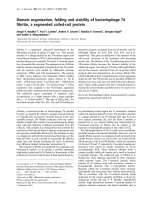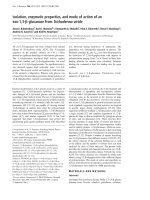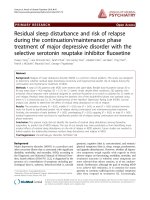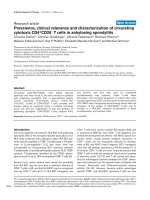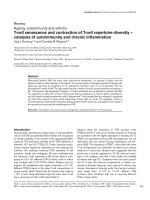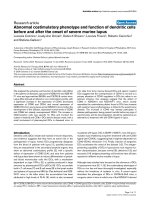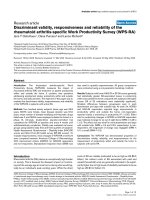Báo cáo y học: "Passive leg elevation and head-down tilt: effects and duration of change" pps
Bạn đang xem bản rút gọn của tài liệu. Xem và tải ngay bản đầy đủ của tài liệu tại đây (24.67 KB, 1 trang )
246
HDT = head-down tilt; PLE = passive leg elevation.
Critical Care June 2003 Vol 7 No 3 McHugh
I am intrigued by the recent further evaluation of passive leg
elevation (PLE) in the perioperative period for patients
undergoing cardiac surgery [1].
Following prior involvement with somewhat similar
evaluations [2], I am left wondering what conclusions may
have been reached if the experimental protocol had been
expanded to include a penultimate assessment with the legs
still elevated (i.e. between time point 3 and time point 4), and
also to examine the effects of head-down tilt (HDT) as used
during central venous cannulation.
On the one hand, the autonomic [2] and haemodynamic
effects [3–5] of postural manipulation have been shown to
be both minimal and short lived. I surmise that the adverse
effects observed may have been self-correcting during the
course of PLE, rather than only after resumption of the supine
position (i.e. before time point 4). This perhaps thereby
minimises the clinical importance of these effects. On the
other hand, the patterns of changes seen with HDT are very
similar to those induced by PLE [2,3].
It follows that any caution advised regarding PLE for patients
known to have reduced right ventricular ejection fraction
should be extrapolated to the use of HDT for central venous
catheter placement. The data provided could justifiably be
added to a list of reasons for avoiding the indiscriminate use
of PLE as a therapeutic manoeuvre in hypotensive conditions.
As for other applications, it is difficult to think of an immediate
alternative to PLE for the preparation of the sterile field
required for a coronary artery bypass vein graft requiring use
of harvested saphenous veins (or to HDT in central venous
catheter placement). The advised caution deserves due
consideration for both PLE and HDT.
Competing interests
None declared.
References
1. Bertolissi M, Da Broi U, Solando F, Bassi F: Influence of passive
leg elevation on the right ventricular function in anaesthetized
coronary patients. Crit Care 2003, 7:164-170.
2. McHugh GJ, Sleigh JW, Bo H, Henderson JD: Heart rate vari-
ability following cardiac surgery fails to predict short-term
cardiovascular instability. Anaesth Intens Care 1997, 25:621-
626.
3. Reich DL, Konstadt SN, Raissi S, Hubbard M, Thys DM: Trende-
lenberg position and passive leg raising do not significantly
improve cardiopulmonary performance in the anesthetized
patient with coronary artery disease. Crit Care Med 1989, 17:
313-317.
4. Gaffney FA, Bastian BC, Thal ER, Atkins JM, Blomqvist CG:
Passive leg raising does not produce a significant or sus-
tained autotransfusion effect. J Trauma 1982, 22:190-193.
5. Terai C, Ananda H, Matsushima S, Shimizu S, Okada Y: Effects
of mild Trendelenberg on central hemodynamics and internal
jugular vein velocity, cross-sectional area, and flow. Am J
Emerg Med 1995, 13:255-258.
Letter
Passive leg elevation and head-down tilt: effects and duration of
changes
Gerard McHugh
Acting Director Intensive Care, Department of Anaesthesia and Intensive Care, Palmerston North Hospital, New Zealand
Correspondence: Gerard McHugh,
Published online: 6 May 2003 Critical Care 2003, 7:246 (DOI 10.1186/cc2186)
This article is online at />© 2003 BioMed Central Ltd (Print ISSN 1364-8535; Online ISSN 1466-609X)


